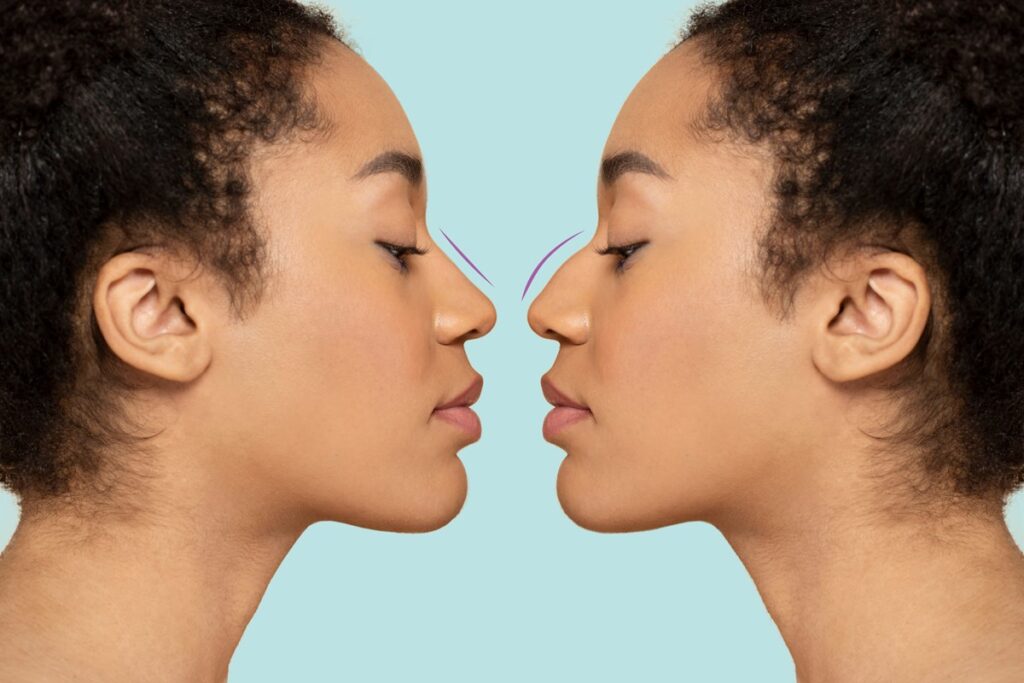Rhinoplasty (Nose Surgery) is a cosmetic procedure to reshape the nose to enhance facial symmetry and the proportions of your nose.
Rhinoplasty helps to improve the physical appearance after an injury or disease. It can also correct breathing difficulties caused by structural defects in the nose.
Types of Rhinoplasty
Open rhinoplasty: This is the most common type of rhinoplasty, where the surgeon makes a small incision on the outside of the nose and lifts the skin to access the underlying cartilage and bone.
Closed rhinoplasty: In this type of rhinoplasty, the surgeon makes all the incisions inside the nose, without lifting the skin on the outside.
Reduction rhinoplasty: This procedure is done to reduce the size of the nose. The surgeon removes cartilage and bone from the nose to achieve a more balanced and proportionate appearance.
Augmentation rhinoplasty: This is done to increase the size of the nose. The surgeon may use cartilage grafts or implants to achieve the desired shape and size.
Ethnic rhinoplasty: This type of rhinoplasty is performed to enhance the appearance of the nose while still maintaining the patient’s ethnic features. The surgeon works with the patient to achieve a result that is in harmony with their facial features and cultural identity.
Revision rhinoplasty: This is done to correct problems or unsatisfactory results from a previous rhinoplasty procedure. The surgeon may need to perform additional procedures, such as cartilage grafting or bone restructuring, to achieve the desired outcome.
What Can Rhinoplasty Treat?
- To straighten, increase or decrease the size of your nose
- To change the shape of the tip of the nose
- To change the nose profile with visible bumps or depressions on the bridge
- To change the shape of the nostrils that are large, wide, or upturned
How to Prepare for Rhinoplasty?
- Avoid smoking two weeks before and two weeks after surgery, as smoking delay healing
- Avoid sun damage two weeks before surgery
- Do not consume anything, even water, on the morning of surgery
- Avoid taking aspirin, herbal supplements, and anti-inflammatory drugs as they can increase bleeding
What to Expect During Rhinoplasty?
- Under general or local anesthesia, the surgeon will make a small incision inside your nose
- Your surgeon will gently raise the skin covering the nasal bones and cartilage to reshape the structure of your nose
A healthy lifestyle and long-term sun protection will help extend the results of your new appearance.
Rhinoplasty Recovery Care
- There will be mild swelling and bruising around your eyes and nose for one to two weeks
- Avoid blowing your nose for a week to avoid bleeding
- To protect your nose, sneeze while keeping your mouth open
- There may be blood-colored watery discharge from your nose for the first two weeks, which is normal
- There will be a blockage of your nose, like a heavy cold, for 10-14 days following the surgery
- It may take around three months to restore normal breathing
- Avoid showers while you have bandages on your nose; instead, take a bath
- Avoid dusty or smoky places
- Avoid strenuous activities such as jogging or aerobics
- Do not put anything on your nose after surgery (ice or cold packs)
- Avoid extreme facial expressions (smiling or laughing)
- Try sleeping upright with extra pillows for a few days to reduce bleeding and swelling
- Brush your teeth gently to limit the movement of your upper lip
- Use sunscreen and a hat for at least six months while going out in the sun
Do’s and Don’ts After Rhinoplasty
Do’s
- Do give yourself time to recover
- Do limit the movements of your lips
- Do increase your fiber intake
- Do continue to avoid smoking
Don’ts
- Do not put anything in your nose
- Do not sneeze
- Do not participate in heavy activities
- Do not expose yourself to sunlight
Myth and Fact: Rhinoplasty
Myth: Rhinoplasty procedures are painful
Fact: You will be under general anesthesia, so you do not feel any pain
Conclusion
Rhinoplasty is a cosmetic procedure that can enhance the appearance and structure of the nose. It can address a range of issues, such as correcting breathing difficulties and improving facial symmetry. However, it is important to carefully consider the procedure, including the risks and benefits, before undergoing surgery. Consulting with a qualified and experienced surgeon, following pre-operative and post-operative instructions, and maintaining a healthy lifestyle can help ensure the best possible outcome for those considering rhinoplasty.


